Sea trout fishery statistics: 2020
Summary of the sea trout fishery statistics for the 2020 season.
Sea Trout fishery statistics - 2020 season
This publication summarises the sea trout fishery statistics, based on returns from proprietors, occupiers or agents of fisheries throughout Scotland, for the 2020 fishing season. These data are derived from 1,961 forms returned from 2,155 forms issued (91% return rate). Catches for the previous 10 years are based on return rates of between 93% and 94%.
These statistics are part of a time series which began in 1952 and are collected and collated by Marine Scotland Science.
Summary
- The total reported rod catch of sea trout for 2020 is 13,313. This is the third lowest on record and 74% of the previous five year average, although the impact of the coronavirus pandemic complicates direct comparisons with previous years.
- Catch and release in 2020 accounted for 88% of the total rod catch. This is the second highest proportion of released rod caught fish since records began in 1994. A proportion of the fish released may be re-caught and inflate the catch statistic by appearing in the reported data more than once.
- Reported catch and effort for the fixed engine and net & coble fisheries are amongst the lowest recorded since records began in 1952.
Time series data
Catch data for the 1952-2020 time series and the 2020 season are available for download from the Marine Scotland Data Portal at the smallest geographical resolution possible given current data protection regulations.
Salmon Fishery Regulations
Statutory conservation measures are in place to regulate both the killing of salmon in the early months of the fishing season, in coastal waters and on stocks with poor conservation status. Although specifically related to the catches of salmon, these regulations may have an impact on the catch and effort data reported by Scottish sea trout fisheries as some target both species.
Catch and Effort Reported by Scottish sea trout Fisheries in 2020
The rod fishery
Of the 13,313 sea trout reported caught in the rod fishery, 11,748 were subsequently released and 1,565 retained. Total rod catch of sea trout has declined over much of the period since 1952, when our records began. The 2020 total rod catch is the lowest on record and 74% of the previous five year average (Figure 1).
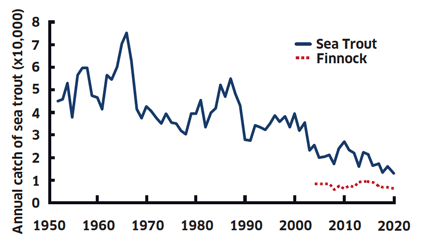
Finnock are sea trout which have spent less than a year at sea and are making their first return to fresh water. They may also be known as whitling or herling. In the rod fishery 6,413 finnock were reported as caught and released, and 291 were reported as caught and retained. The combined total, of 6,704, is 76% of the previous five year average and the third lowest since our records began in 2004 (Figure 1). Finnock catches are not included in the sea trout data.
Catch and release
The proportion of the rod catch accounted for by catch and release has generally increased since 1994, when catch and release information was first recorded (Figure 2), but has fallen slightly since its peak in 2018. The proportion released was 88% of sea trout and 96% of finnock. A proportion of fish released from the rod fishery may be re-caught and hence inflate the catch statistics by appearing in the reported data more than once.
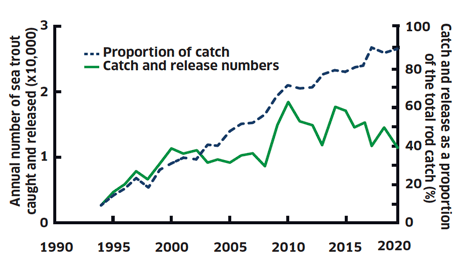
The net fisheries
A total of 30 sea trout were reported caught and retained in the Solway haaf net fishery from a reported effort of four net months. Effort data from haaf net fisheries is omitted from the national fixed engine effort as it cannot easily be combined with other gear types.
A total of 86 sea trout were reported caught and retained in the fixed engine fishery, from a reported effort of three crew months.
A total of 567 sea trout were reported caught and retained in the net & coble fishery, from a reported effort of 15.5 crew months.
Reported catch and effort in both net fisheries have declined over much of the period covered by our records and remain at low levels (Figures 3 & 4).
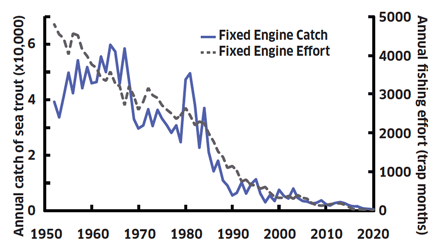
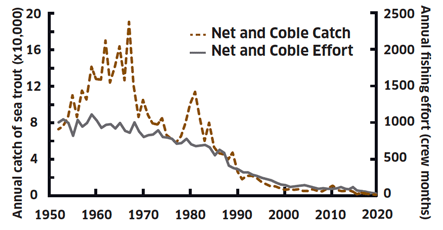
The catch by fishing method
In 2020, 95% of the total annual reported catch was accounted for by the rod fisheries. Net and coble fisheries comprised 4% and fixed engine fisheries accounted for 1%. Of the retained catch, rods accounted for 70% compared to 5% and 25% for fixed engine and net & coble fisheries respectively.
Coronavirus (COVID-19)
The coronavirus pandemic has undoubtedly had a negative impact on Scottish sea trout fisheries during the 2020 season. Stay at home orders during this time along with the restrictions on national and international travel severely disrupted fisheries. This disruption may ultimately have led to lower catches (Figure 5) and makes comparisons with previous years complex.
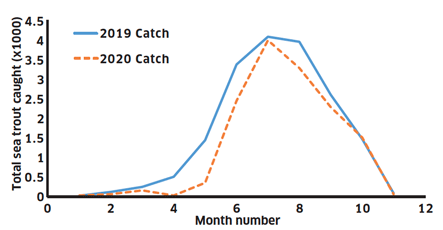
Downloads
Topic sheet no. 67 (Collecting the Marine Scotland Salmon and Sea Trout Fishery Statistics) explains how we collect the catch statistics.
Topic sheet no. 68 (Salmon Fishery Statistics) summarises the salmon fishery statistics for the 2020 fishing season.
Both topic sheets are available for download at https://www.gov.scot/publications/marine-publications-information-on-scottish-salmon-and-sea-trout-statistics/.
Summary data for fishing seasons 1952 to 2020 are available from our data visualisation application (https://scotland.shinyapps.io/sg-salmon-sea-trout-catch/), whilst more detailed data can be obtained from the Marine Scotland Data Portal. These data are provided as the most complete at the time of publication. Our records are amended when further information becomes available and updated annually when the statistics for the most recent fishing season are published.
Contact
If you have a specific request for Scottish salmon and sea trout fishery information, not available at the links provided on this page, please contact us directly at ms.catchform@gov.scot
Contact
Email: ms.catchform@gov.scot
There is a problem
Thanks for your feedback